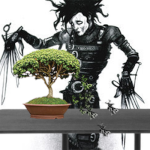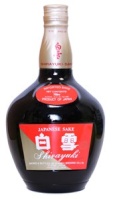Cracked pot...repair or discard?
+9
lordy
bucknbonsai
Dale Cochoy
SamC
rock
JimLewis
landerloos
Billy M. Rhodes
Poink88
13 posters
Page 1 of 1
 Cracked pot...repair or discard?
Cracked pot...repair or discard?
A while back I bought a (Japanese/Kaiyou) pot online and it arrived cracked (@#%$# shipping company!  ). It is only hairline but ran about half way the pot w/o any chips.
). It is only hairline but ran about half way the pot w/o any chips.
Vendor refunded my money and gave me the pot to use if I can. I applied thin then thick crazy glue (cyanoacrylate) in and on it and the crack is hardly visible now from the outside unless you look really close. Question is whether I should reinforce it with something else and use the pot or not.
What would you do?
Vendor refunded my money and gave me the pot to use if I can. I applied thin then thick crazy glue (cyanoacrylate) in and on it and the crack is hardly visible now from the outside unless you look really close. Question is whether I should reinforce it with something else and use the pot or not.
What would you do?

Poink88- Member
 Re: Cracked pot...repair or discard?
Re: Cracked pot...repair or discard?
Use the pot but not for something you plan to show and avoid extremes in temperature that might cause expansion or contraction since the SG probably will not expand or contract at the same rate as the unglued areas.

Billy M. Rhodes- Member
 Re: Cracked pot...repair or discard?
Re: Cracked pot...repair or discard?
Thanks Billy,
In the future (and for others education as well) if this happens again...what is the best material to use mending a cracked pot?
In the future (and for others education as well) if this happens again...what is the best material to use mending a cracked pot?

Poink88- Member
 Re: Cracked pot...repair or discard?
Re: Cracked pot...repair or discard?
You could see it as patina, why not use for show, just make sure its in the back.
Peter
Peter

landerloos- Member
 Re: Cracked pot...repair or discard?
Re: Cracked pot...repair or discard?
"Cracked" pots are a conundrum. It is virtually impossible to repair them. It would be much better if the pot had broken into two or more pieces, in which case, the super glue could actually have repaired the breaks. As it is, it sounds as if you've put a layer of glue over the cracks, but it hasn't gotten to the structural break itself.
Be sure this pot never freezes -- although if it did, you could make a better stab at repair.
Be sure this pot never freezes -- although if it did, you could make a better stab at repair.

JimLewis- Member
 Re: Cracked pot...repair or discard?
Re: Cracked pot...repair or discard?
Jim,JimLewis wrote:"Cracked" pots are a conundrum. It is virtually impossible to repair them. It would be much better if the pot had broken into two or more pieces, in which case, the super glue could actually have repaired the breaks. As it is, it sounds as if you've put a layer of glue over the cracks, but it hasn't gotten to the structural break itself.
Be sure this pot never freezes -- although if it did, you could make a better stab at repair.
The thin (cyanoacrylate) CA actually seeped in the cracks. I applied it from the inside until I saw it seeping outside/bottom which is taped earlier to prevent it from spreading too much and becoming more visible. I was more careful on the side but same technique was used. I then applied thick CA inside but doubt any of it went in much.
Some people don't know but water (or acetone) cures CA. I dabbed the outer wall a bit so it is moist...the CA upon contact will cure and harden almost instantly before it shows outside. That and the tape took care of it.
My concern is that since the pot is fired, there might not be enough pores for the glue to bind it properly. Time will tell. Regarding freezing temps, we hardly get any here in TX and when it does...almost all my trees are brought in. It will be years before I can bonsai pot any of my stumps anyway LOL.
Thanks!

Poink88- Member
 Re: Cracked pot...repair or discard?
Re: Cracked pot...repair or discard?
I've dealt with very nearly the same thing a few times, save that it wasn't with a nice imported pot.
I was given a large, really inexpensive Chinese blue glazed rectangular pot that undoubtedly once held some mallsai of one sort of another. It had a crack that traveled nearly across the entire pot from front to back. This one I actually gently pulled and it broke in half. I have found that rather porous low-temp fired ceramics can be repaired with Gorilla Glue, which is a type of cyanoacrylate so it catalyzes with water. The only problem is that it was large enough I had quite a difficult time getting the sides to line up exactly. Once it was cured, I could feel that things had shifted ever so slightly. Probably good enough for a training pot for my yard. The Gorilla Glue should be very waterproof and resist stresses from cold/heat cycles as it is (very) slightly flexible. If this was a nice pot, I would probably research some solvents and give it another go...at this point, "good enough", as it isn't really noticeable to the eye.
I have recently had a chance to do some ceramic repair work (OOPS!), and found that the Elmer's Ceramic/Glass repair cement is just a pain to work with, and did not perform well at all. On the other hand, the Liquid Nails Small Ceramic Projects Repair Adhesive outperformed several industrial adhesives I had used in some materials classes in college. If I ever need to repair fine china, glassware, high-fired ceramics, I will plan on using the Liquid Nails product (but I would be wary of using it on projects that would be subjected to being wetted and freezing...ice forming in a minute crack is going to generate a lot of pressure, and this is another case where a flexible adhesive would be better than a brittle cement like most cyanoacrylate cements.
My old jewelry instructor commented that professional ceramics repairers will coat the crack line with a semi-thick cyanoacrylate, place the item in a vacuum chamber, then take the pressure down, which will cause the air in the crack to bubble out. Once the vacuum is drawn, air is allowed to re-enter the chamber and the vacuum now in the crack will suck the cyanoacrylate deep inside. (This is also how ivory, antler, and some woods can be stabilized for jewelry and knife handles).
Otherwise, I would just be really careful with most cements and adhesives on non-glazed pots, if you get it on an unglazed surface, I think you will likely see it forever.
As Rock posted, Kintsugi would be a very very traditional repair method. I actually have some powdered gold among some art supplies, but trying to determine and obtain the correct lacquer has stopped me from trying this technique.
I was given a large, really inexpensive Chinese blue glazed rectangular pot that undoubtedly once held some mallsai of one sort of another. It had a crack that traveled nearly across the entire pot from front to back. This one I actually gently pulled and it broke in half. I have found that rather porous low-temp fired ceramics can be repaired with Gorilla Glue, which is a type of cyanoacrylate so it catalyzes with water. The only problem is that it was large enough I had quite a difficult time getting the sides to line up exactly. Once it was cured, I could feel that things had shifted ever so slightly. Probably good enough for a training pot for my yard. The Gorilla Glue should be very waterproof and resist stresses from cold/heat cycles as it is (very) slightly flexible. If this was a nice pot, I would probably research some solvents and give it another go...at this point, "good enough", as it isn't really noticeable to the eye.
I have recently had a chance to do some ceramic repair work (OOPS!), and found that the Elmer's Ceramic/Glass repair cement is just a pain to work with, and did not perform well at all. On the other hand, the Liquid Nails Small Ceramic Projects Repair Adhesive outperformed several industrial adhesives I had used in some materials classes in college. If I ever need to repair fine china, glassware, high-fired ceramics, I will plan on using the Liquid Nails product (but I would be wary of using it on projects that would be subjected to being wetted and freezing...ice forming in a minute crack is going to generate a lot of pressure, and this is another case where a flexible adhesive would be better than a brittle cement like most cyanoacrylate cements.
My old jewelry instructor commented that professional ceramics repairers will coat the crack line with a semi-thick cyanoacrylate, place the item in a vacuum chamber, then take the pressure down, which will cause the air in the crack to bubble out. Once the vacuum is drawn, air is allowed to re-enter the chamber and the vacuum now in the crack will suck the cyanoacrylate deep inside. (This is also how ivory, antler, and some woods can be stabilized for jewelry and knife handles).
Otherwise, I would just be really careful with most cements and adhesives on non-glazed pots, if you get it on an unglazed surface, I think you will likely see it forever.
As Rock posted, Kintsugi would be a very very traditional repair method. I actually have some powdered gold among some art supplies, but trying to determine and obtain the correct lacquer has stopped me from trying this technique.
SamC- Member
 Re: Cracked pot...repair or discard?
Re: Cracked pot...repair or discard?
If this is going to be a 'working pot' I would not hesitate to repair from inside using a bead of GORILLA GLUE. I found this Excellent for repairing cracks across entire pots that are used outside and even frozen. the frozen soil and moisture don't seem to effect it even after a few years. i have quite a few larger pots and my own '2nds' in use with it and found it much better than SUPER GLUE and epoxy ( which is worthless IMO) . I think it would work fine over top of the repair you have now. It does seep into the cracks and if the pot is moistened first it will travel entirely through the crack needing to be shaved off as it hardens on the outside. It foams, so try it out first, however, it doesn't really matter if used on a 'working' pot.
Here is a repaired pot I had made as a commissioned pot for someones azalea, and found it cracked in last firing. I kept it, repaired with Gorilla glue, potted an azalea in it, and it's on it's second winter now. here is a shot from last spring before it was trimmed.


Here is a repaired pot I had made as a commissioned pot for someones azalea, and found it cracked in last firing. I kept it, repaired with Gorilla glue, potted an azalea in it, and it's on it's second winter now. here is a shot from last spring before it was trimmed.



Dale Cochoy- Member
 Re: Cracked pot...repair or discard?
Re: Cracked pot...repair or discard?
Thanks Dale and SamC,
Gorilla Glue will be it next time then . I got my answer and I hope others learned from this as well.
. I got my answer and I hope others learned from this as well.
Gorilla Glue will be it next time then

Poink88- Member
 Re: Cracked pot...repair or discard?
Re: Cracked pot...repair or discard?
go to lowes, get fiberglass mesh and resin. apply to underside and on the inside. it will be stronger than He-man. Thats how I fixed a big one. use LOTS of ventilation when applying it.

bucknbonsai- Member
 Re: Cracked pot...repair or discard?
Re: Cracked pot...repair or discard?
I too used Gorilla glue on one I broke. I planted what used to be in it, so it has not had a tree in it over the winter, so I dont know if my repair will hold up. Luckily the pot was about the same color as the foam that results when Gorilla glue dries, so it isnt very noticable, and I wouldnt use it for public display, but I still can use it. 
As far as fiberglass goes, that probably wont work on a glazed pot as there is nothing for the resin to grip. And unless you have a really expensive pot, you will probably spend more for the fiberglass etc than the pot is worth. I guess we need to face the fact that most repairs to cracked pots are A) not for display and B) probably short-lived.
As far as fiberglass goes, that probably wont work on a glazed pot as there is nothing for the resin to grip. And unless you have a really expensive pot, you will probably spend more for the fiberglass etc than the pot is worth. I guess we need to face the fact that most repairs to cracked pots are A) not for display and B) probably short-lived.

lordy- Member
 Re: Cracked pot...repair or discard?
Re: Cracked pot...repair or discard?
good hints...........i give my cracked ones to the club raffle and if Gordon the potter wins he puts a clay patch over it and fires it.I have one cracked pot outside with a maple in it, repaired with a clay patch and it is 3 winters now
gorila glue or uk 'no more nails' do a great job on outdoor ceramics too
cheers Marcus
gorila glue or uk 'no more nails' do a great job on outdoor ceramics too
cheers Marcus

marcus watts- Member
 Re: Cracked pot...repair or discard?
Re: Cracked pot...repair or discard?
On the aesthetic side my wife saw a show in Washington DC a few years ago on Kintsugi. I would love to use it some day if I had a pot worth the effort. I love the idea and the results. More HERE
I would love to know what this is exactly so I could tell my wife about it (she is a ceramicist). I didn't even think that was possible?
Gordon the potter wins he puts a clay patch over it and fires it
I would love to know what this is exactly so I could tell my wife about it (she is a ceramicist). I didn't even think that was possible?

Jim Doiron- Member
 Cracked or broken pot traditional reapir and kintsugi, mending with gold
Cracked or broken pot traditional reapir and kintsugi, mending with gold
Hello,
Perhaps you wish to visit the following link for several pottery repair and restoration tutorials and step by step illustrations:
How to repair bonsai pots - link


We also get requests for the bonsai community to repair bonsai plants and tray using the traditional Japanese method of kintsugi, mending with gold. Note that some usage limitation exist with ceramic repair depending where it is broken and how to pot is used.
Repair Bonsai pots with gold- link


Kindly, Patty and Morty
Perhaps you wish to visit the following link for several pottery repair and restoration tutorials and step by step illustrations:
How to repair bonsai pots - link


We also get requests for the bonsai community to repair bonsai plants and tray using the traditional Japanese method of kintsugi, mending with gold. Note that some usage limitation exist with ceramic repair depending where it is broken and how to pot is used.
Repair Bonsai pots with gold- link


Kindly, Patty and Morty
lakesidepottery- Member
 Re: Cracked pot...repair or discard?
Re: Cracked pot...repair or discard?
lordy wrote:I too used Gorilla glue on one I broke. I planted what used to be in it, so it has not had a tree in it over the winter, so I dont know if my repair will hold up. Luckily the pot was about the same color as the foam that results when Gorilla glue dries, so it isnt very noticable, and I wouldnt use it for public display, but I still can use it.
As far as fiberglass goes, that probably wont work on a glazed pot as there is nothing for the resin to grip. And unless you have a really expensive pot, you will probably spend more for the fiberglass etc than the pot is worth. I guess we need to face the fact that most repairs to cracked pots are A) not for display and B) probably short-lived.
My gorilla glue lasts for YEARS inside the pots with tree, soil and water and freezing. you don't need it on the OUTSIDE, Just the inside. see my photo. if any squeezes through the fine crack to the outside it will cut off nicely with a razor and you'll never see it.

Dale Cochoy- Member
 Re: Cracked pot...repair or discard?
Re: Cracked pot...repair or discard?
I have used a combination of a physical glue and a low firing frit.
A slow firing in the kiln and the pot is as was.
Khaimraj
A slow firing in the kiln and the pot is as was.
Khaimraj

Khaimraj Seepersad- Member
 Re: Cracked pot...repair or discard?
Re: Cracked pot...repair or discard?
Khaimraj Seepersad wrote:I have used a combination of a physical glue and a low firing frit.
A slow firing in the kiln and the pot is as was.
Khaimraj
Hmmmm?
I'm curious?
How many times have you REFIRED a cracked pot and had it come out again 'as it was' ?

Dale Cochoy- Member
 Re: Cracked pot...repair or discard?
Re: Cracked pot...repair or discard?
Dale,
I did research into enamel glazes, and as such have a small range of non-toxic enamel frits that can gloss at 650 to 690 deg.C.
This will not normally disturb either an earthenware body or earthenware glaze [ or stoneware/porcelain glaze /body ].
Does this help?
Khaimraj
I did research into enamel glazes, and as such have a small range of non-toxic enamel frits that can gloss at 650 to 690 deg.C.
This will not normally disturb either an earthenware body or earthenware glaze [ or stoneware/porcelain glaze /body ].
Does this help?
Khaimraj

Khaimraj Seepersad- Member
 Re: Cracked pot...repair or discard?
Re: Cracked pot...repair or discard?
Fortunately the pot that broke was not a Dale Cochoy original... Those that I own are safe and sound under a foot of SNOW, DAMMIT!! I WANT SPRINGTIME.Dale Cochoy wrote:lordy wrote:I too used Gorilla glue on one I broke. I planted what used to be in it, so it has not had a tree in it over the winter, so I dont know if my repair will hold up. Luckily the pot was about the same color as the foam that results when Gorilla glue dries, so it isnt very noticable, and I wouldnt use it for public display, but I still can use it.
As far as fiberglass goes, that probably wont work on a glazed pot as there is nothing for the resin to grip. And unless you have a really expensive pot, you will probably spend more for the fiberglass etc than the pot is worth. I guess we need to face the fact that most repairs to cracked pots are A) not for display and B) probably short-lived.
My gorilla glue lasts for YEARS inside the pots with tree, soil and water and freezing. you don't need it on the OUTSIDE, Just the inside. see my photo. if any squeezes through the fine crack to the outside it will cut off nicely with a razor and you'll never see it.

lordy- Member
 Similar topics
Similar topics» Cracked pot repair
» The Waterfall Scroll that was sold
» cracked pots
» Spring - Summer displays
» Linden trunk-cracked
» The Waterfall Scroll that was sold
» cracked pots
» Spring - Summer displays
» Linden trunk-cracked
Page 1 of 1
Permissions in this forum:
You cannot reply to topics in this forum






